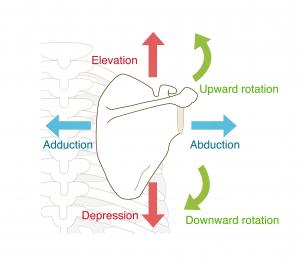
The Brookbush Institute Enhances Anatomy Education with an Update to 'Joints of the Shoulder Girdle and Scapular Motion'
Learn about protraction, retraction, elevation, depression, upward rotation, etc., along with all of the muscles responsible for these joint actions.
- Additional Study Aids: Protraction, Retraction
JOINT ACTIONS OF THE SCAPULA
The scapula has its own set of joint actions: The shoulder girdle has a set of joint actions specific to motion of the scapula.
Although this may seem like just another set of confusing terms to memorize, it is actually fortunate that we have a separate set of terms to use. When we start analyzing scapulohumeral motion in later lessons it reduces confusion between the motion that is specific to the shoulder and the motion that is specific to the shoulder girdle (scapula).
- Protraction – The scapula move away from the mid-line of the body and follow the curvature of the rib cage in lateral and anterior fashion.
- Retraction – The scapula move toward the mid-line of the body and follow the curvature of the rib cage in a medial and posterior fashion.
- Elevation – The scapula move in a superior direction.
- Depression – The scapula move in an inferior direction.
- Upward Rotation– The inferior angle of the scapula moves in a superior-lateral direction such that the glenoid fossa faces upward.
- Downward Rotation - The inferior angle of the scapula moves in an inferior-medial direction such that the glenoid fossa faces downward.
- Anterior Tipping – The superior portion of the scapula pivots anteriorly on the thorax
- Posterior Tipping – The superior portion of the scapula pivots posteriorly on the thorax
COURSE INTRODUCTION
The scapula (shoulder blade) and shoulder girdle are comprised of two joints, the acromioclavicular joint (AC joint) and sternoclavicular joint (SC joint), and analysis of the motion usually refers to a false joint known as the scapulothoracic joint. The scapulothoracic joint is not a true joint because there are no joint capsules or ligaments connecting the scapula to the thoracic spine or rib cage. The scapula is held to the thorax by scapular muscle activity, and the joints connecting the clavicle (collar bone) to the scapula and sternum.
The name of the joint actions of the scapula are different than the joint actions commonly used for other synovial joints of the body. The eight additional joint actions for describing scapulothoracic motion include protraction, retraction, depression, elevation, upward rotation, downward rotation, anterior tipping, and posterior tipping. Note, these joint actions correspond to the planes of motion and recruitment of muscles.
For example, the concentric phase of a wide-grip (conventional) pull-up is an example of shoulder adduction and scapular downward rotation, downward rotation is a frontal plane motion that is the result of pectoralis minor, rhomboid, and levator scapulae recruitment.
Another example, the concentric phase of a shoulder press is an example of upward rotation and elevation of the scapula, both actions occurring in the frontal plane; however, to achieve a full range of motion at the shoulder joint (glenohumeral joint) the scapula will also posteriorly tip, which is a sagittal plane motion.
Sports medicine professionals (personal trainers, fitness instructors, physical therapists, massage therapists, chiropractors, occupational therapists, athletic trainers, etc.) must be aware of the shoulder girdle and scapula joint actions for detailed analysis of human movement, and the development of sophisticated exercise programs and therapeutic (rehabilitation) interventions.
Further, this course is essential knowledge for future courses discussing scapular muscles (e.g. the serratus anterior), shoulder muscles (e.g. rotator cuff), upper arm muscles (e.g. biceps brachii), and vertebral column muscles (e.g. rhomboids). In addition, this knowledge is fundamental to more complex topics like scapular kinematics (relationship between scapular motion, the glenoid cavity, and the humeral head), role in injury (e.g. shoulder pain, shoulder impingement syndrome, rotator cuff strain/tear, frozen shoulder - you don't always need rotator cuff repair), and sports performance (e.g. throwing, shooting, punching, lifting).
Brent Brookbush
Brookbush Institute
Support@BrookbushInstitute.com
Visit us on social media:
Facebook
X
LinkedIn
Instagram
YouTube
TikTok
Other
Distribution channels: Education, Healthcare & Pharmaceuticals Industry, Science, Social Media, Sports, Fitness & Recreation
Legal Disclaimer:
EIN Presswire provides this news content "as is" without warranty of any kind. We do not accept any responsibility or liability for the accuracy, content, images, videos, licenses, completeness, legality, or reliability of the information contained in this article. If you have any complaints or copyright issues related to this article, kindly contact the author above.
Submit your press release
